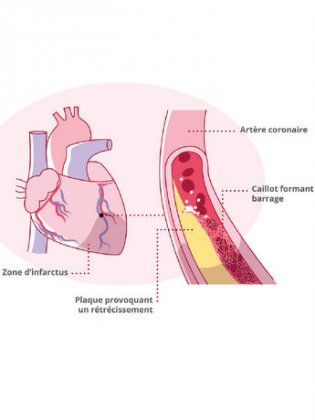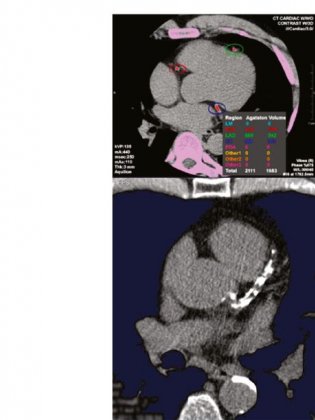Calcium Score
How to prevent a heart attack?
What is a heart attack?
-
Myocardial infarction
This happens when one of the vessels that supplies blood to the heart is blocked, causing one part of the heart to be deprived of blood. If the area in question is large, the heart cannot longer perform its normal functions, and death can occur.
-
“Acute coronary syndrome” or unstable angina
This cardiovascular event that is usually less serious can occur if one of the vessels that supplies blood to the heart becomes very narrowed, but not totally blocked: there is a poor and insufficient supply of blood in the heart.
-
“Sudden death”
“Sudden death” remains the most unpredictable and most drastic cardiovascular event. It is the unexpected death of a person that occurs in less than an hour. This is not uncommon, and usually occurs in people with “atheroma” in their coronary vessels.
What is coronary atheroma?
Coronary arteries are small arteries that supply blood to the heart.
They are 3 main arteries, with diameters of about 2 to 5 millimeters. Atheroma is a pathological tissue i.e. abnormal - tissue consisting of fat, fibrous tissue and calcium.
Atheroma originates in the wall of the coronary arteries but can develop to the point of partially - or even completely - obstructing the coronary vessel, thus leading to the conditions described above.

How does atheroma form on the coronary arteries?
We do not know for sure... There are so-called “risk factors” that statistically increase the likelihood of developing coronary atheroma. The main risk factors are diabetes, smoking, arterial hypertension, excess cholesterol, obesity and a sedentary lifestyle. The contribution of a genetic predisposition is also well documented: persons whose parents have had heart attacks also have increased risks.
With the aid of a very simple exam: calcium score
This exam is done using a CAT scan, without the need for an infusion or an injection.
The only thing you will be asked to do is not to breathe for a few seconds, like a simple X-ray. The images captured show the deposits of calcified atheroma on your coronary arteries.
A specific software then calculates a number that quantifies the amount of these atheroma deposits: this is the calcium score.
The calcium score is calculated as follows: the operator designates each plate, whose score is calculated by a specific software, which takes into account the size of this plate, and its density. The sum of the scores of all the plates is the calcium score, as developed by Agatston.
One important point worth noting is that the calcium score - as its name indicates - quantifies the lesions of calcified atheroma, but there is a very good correlation between the extent of calcified and non-calcified lesions, so that the calcium score is ultimately a good indicator of the total load of the coronary atheroma.

The calcium score is the only test that can quantify the extent of coronary atheroma damage, and it is the best predictor of the risk of heart attack.
What are we going to do with the results of your calcium score?
-
If your calcium is low, less than 100
This means that your risk of heart attack is very low, less than 1% per year. There is no need for further tests or to make any significant changes to your lifestyle. It should be noted that these recommendations apply to subjects aged 60 and above: a calcium score other than 0 in a subject under 50 years of age indicates the presence of early coronary atheroma, in which case taking specific measures is necessary.
-
Your calcium score is average between 100 and 300
This result shows there are small deposits in your coronary arteries. It is important to make sure that these deposits do not increase in the future.
To do this, there are 3 possible ways of doing this: diet, physical exercise and certain medication. A combined use of these 3 measures can reduce the risk of a heart attack by more than 50%.
-
If your calcium score is higher than 300
It is advisable to make sure that the atheromatous deposits do not interfere with the normal flow of blood through your coronary arteries. Other tests referred to as "ischemia tests" will therefore be necessary: if the results of these tests are normal, it means that these deposits do not interfere with the proper flow of blood to your heart. Therefore, the 3 recommended measures (diet, physical activity, medication) remain valid.
If, on the contrary, an abnormality in the circulation of blood in your heart is detected (during exercise for example), a coronary angiography will be required, if necessary, stents will be put in it.
An ischemia test is a test that determines if the blood supply to your heart is normal, in resting or “stressed” situations such as during physical activity. There are 3 ischemia tests: myocardial scintigraphy, ultrasound and stress MRI.
Coronary angiography is an "invasive" examination, i.e. involving a puncture in an artery. It involves the injection of a contrast material directly into your coronary arteries: the images obtained are therefore a kind of "mold" of your coronary vessels. They show whether there is any narrowing that is more or less tight. If this is the case, one or more stents can be placed in during a coronary angiography.
| Smoking cessation | 50 % |
| Physical activity | 20-30% |
| Dietetics | 14-40% |
Interesting fact: it's easier to reduce a high risk than a low risk: if you have a 20% chance of having a heart attack in the next 10 years, it's probably not that difficult to reduce that risk by half, to 10%. However, if your risk is 2% over the next 20 years, that means an annual risk of 1 in 1000: such a level of risk is almost impossible to reduce, as any action, including medication, can have a negative counterpart.
